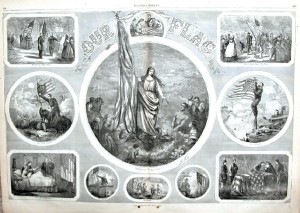“THE ARMY BEFORE PETERSBURG” was among the numerous headlines that drew readers of the Journal to riveting accounts of “the movement of Grant’s army” — horrific details of the terrific explosion that blew up “one of the enemy’s strongest forts” and the “simultaneous charge in which we lost heavily.” The paper’s columns held letters from Hoosier soldiers providing graphic narratives of the fierce fighting before Atlanta — “one of the severest battles — heavy losses on both sides” — and the list of casualties in Indiana regiments in Sherman’s Army; the sick and wounded in Nashville hospitals. Acknowledging that support of those whom a “volunteer has left behind is as solemn and just a debt as any” that the county will be called upon to pay, the county commissioners levied a tax for this month of $1,500 (2013: $22,040.29) for the relief of families of the soldiers.
Captain James Wilson, Quartermaster, bought mules on the open market for $152 (2013: $2,233.42) per head, and over 1,200 had been bought in the first five days of the month. This was the largest number of mules ever purchased here in that short of time for shipment to the Army of the Potomac and the Army of the Cumberland. The returning soldiers of the 18th, 24th, and 32nd regiments received “one of the heartiest welcomes” ever given. After dinner at the Soldiers’ Home, a formal reception was held on the State House yard where a “large concourse of citizens had gathered.” Governor Morton issued general orders for the organization of eleven additional Indiana regiments authorized in response to the President’s call for 500,000 men.
“A day of National humiliation and prayer” proclaimed by President Lincoln for the first Thursday of August “to implore the compassion and forgiveness of the Almighty that…the existing rebellion may be speedily suppressed,” saw services held by all of the city Presbyterian congregations at First Church and services held by all of the city Methodist congregations at Roberts Chapel and Wesley Chapel. All city churches held evening prayer meetings. The practice of “judiciously” scattering watermelon rinds along the sidewalks to provide “convenient aids to locomotion” continued through the month. “The sensation of sliding upon them for several feet is delicious” despite the occasional “broken legs and broken heads.”
The Union Party campaign in Indianapolis opened with meetings held on the Circle every Wednesday and Saturday. Attended by enthusiastic crowds of “loyal men” and “patriotic women,” there were “three cheers for the Government, the army and the navy” and speeches by candidates and invited orators interspersed with “spirited martial music, patriotic airs” furnished by the band of the 17th Reserve Veteran Corps. The massed audience sang “Stand by the Flag of the Nation,” and the Glee Club sang “Freedom Shall not Perish,” “Comrades, Awake to Glory,” and “When the Boys Come Home” to hearty applause. “The Union cause in Indianapolis burns brightly in the hearts of free men.” Arms and ammunition were seized in a raid on the premises of H H Dodd & Co, printers. 18 E. Washington St. Marked for the Sons of Liberty, the large cache consisted of 32 boxes of arms containing 400 navy revolvers and 135,000 rounds. Documents and letters, the official list of members (including J. J. Bingham, editor of the Sentinel; James S. Athon, Indiana secretary of state; Oscar H. Hord, Indiana attorney general) of the Indianapolis Lodge, and several hundred copies of the Ritual were also confiscated. Harrison H. Dodd, Grand Commander, and William H. Harrison, Secretary, were taken into custody.
Indianapolis citizens could choose from a variety of entertainment as the month began. The Ravel Troupe appeared at Metropolitan Hall and the Italian Opera Concert Troupe presented One Grand Operatic Concert at Masonic Hall, while children of all ages eagerly awaited G. F. Bailey & Co.’s “Quadruple Combination” — Grand Circus, Extensive Menagerie, Performing Elephants, and the Gigantic Hippopotamus scheduled for August 12 and 13. Crowds of Indianapolis residents and visitors also were drawn to the “stock of curiosities” at the State Museum in Kinder’s Block, 83-85 E. Washington St.
A raid conducted by Col. Lafayette C. Baker, chief of the U. S. Detectives and officers of the City Police Force, on a house 2½ miles south of the city netted a gang of counterfeiters. Dies and plates for $20 Greenbacks and fifty cent currency, and the press used in printing the bills, were seized. Some of the “well executed” counterfeit money has been found in Indianapolis; $30,000 (2013: $440,805.79) in fake bills has been circulated in Eastern cities. The offenders were taken to the Old Capitol Prison in Washington. The increase in “juvenile criminality” by Indianapolis boys was “getting very bad.” If lads stealing, robbing, and filching goes on “without restraint, some years hence we will reap a big crop of thieves and burglars.”
“INDIANAPOLIS IN HER HOLIDAY CLOTHES!” greeted the return of nearly 10,000 one-hundred-day volunteers of the City (132nd) Regiment and three other regiments as the month came to an end. Nearly every man, woman and child — family, friends, and citizens — in Indianapolis jammed the State House yard along with the soldiers to hear Gov. Morton proclaim “it is always a subject of thanksgiving when soldiers return.” Thunderous applause from the crowd and ringing huzzahs from the regiments greeted the remarks. Following speeches by other dignitaries, the regiments — City Regiment, the 133rd Regiment, the 134th Regiment, the 136th Regiment, the 60th Massachusetts, together with two regiments of the Veteran Reserve Corps — formed a column, headed by the Governor and his staff with Hahn’s City Band, the City Regimental Brass Band, and the different regimental field bands placed at intervals, and marched east on Washington St from the State House yard to Pennsylvania St. After dismissal, each regiment “wended its way to the respective camps.”



